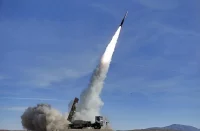Oriental Review is very happy to announce that we will be regularly publishing Andrew Korybko’s latest research on Hybrid Wars. Building off of the strategies that he described in last year’s book of the same name, Andrew has conceptualized a new paradigm for understanding international relations and invented an accompanying methodology for testing it. The “Law Of Hybrid War”, the name of his newest series, states that:
The grand objective behind every Hybrid War is to disrupt multipolar transnational connective projects through externally provoked identity conflicts (ethnic, religious, regional, political, etc.) within a targeted transit state.
Russia’s Eurasian integration objectives and China’s Silk Road projects are the targets of the US’ global Hybrid War strategy, and this accordingly opens up a wide range of geographic battlefields. Andrew examines the Greater Heartland, the Balkans, ASEAN, transoceanic Africa, and Latin America in identifying the vulnerabilities that each of the relevant transit states has to this revolutionary type of asymmetrical warfare.
His unique methodology incorporates the variables of ethnicity, religion, history, administrative boundaries, physical geography, and socio-economic disparity in crafting comprehensive analyses that demonstrate each country’s Hybrid War weaknesses. The objective of the work is to illustrate the means that the US could predictably employ in destabilizing these targeted states, thereby giving decision makers and the public advance notice so that they can be better prepared to deal with certain preplanned scenarios as they arise.
Please visit us to follow the updates of the “Hybrid Wars” series due to be released every Friday starting today.
The Law Of Hybrid Warfare
Hybrid War is one of the most significant strategic developments that the US has ever spearheaded, and the transitioning of Color Revolutions to Unconventional Wars is expected to dominate the destabilizing trends of the coming decades. Those unaccustomed to approaching geopolitics from the Hybrid War perspective might struggle to understand where the next ones might occur, but it’s actually not that difficult to identify the regions and countries most at risk of falling victim to this new form of aggression. The key to the forecast is in accepting that Hybrid Wars are externally provoked asymmetrical conflicts predicated on sabotaging concrete geo-economic interests, and proceeding from this starting point, it’s relatively easy to pinpoint where they might strike next.
The series begin by explaining the patterns behind Hybrid War and deepening the reader’s comprehension of its strategic contours. Afterwards, we will prove how the previously elaborated framework has indeed been at play during the US’ Wars on Syria and Ukraine, its first two Hybrid War victims. Next part reviews all of the lessons that have been learned thus far and applies them in forecasting the next theaters of Hybrid War and the most vulnerable geopolitical triggers within them. Subsequent additions to the series will thenceforth focus on those regions and convey why they’re so strategically and socio-politically vulnerable to becoming the next victims of the US’ post-modern warfare.
Patterning The Hybrid War
 The first thing that one needs to know about Hybrid Wars is that they’re never unleashed against an American ally or anywhere that the US has premier preexisting infrastructural interests. The chaotic processes that are unleashed during the post-modern regime change ploy are impossible to fully control and could potentially engender the same type of geopolitical blowback against the US that Washington is trying to directly or indirectly channel towards its multipolar rivals. Correspondingly, this is why the US won’t ever attempt Hybrid War anywhere that it has interests which are “too big to fail”, although such an assessment is of course contemporaneously relative and could quickly change depending on the geopolitical circumstances. Nevertheless, it remains a general rule of thumb that the US won’t ever intentionally sabotage its own interests unless there’s a scorched-earth benefit in doing so during a theater-wide retreat, in this context conceivably in Saudi Arabia if the US is ever pushed out of the Mideast.
The first thing that one needs to know about Hybrid Wars is that they’re never unleashed against an American ally or anywhere that the US has premier preexisting infrastructural interests. The chaotic processes that are unleashed during the post-modern regime change ploy are impossible to fully control and could potentially engender the same type of geopolitical blowback against the US that Washington is trying to directly or indirectly channel towards its multipolar rivals. Correspondingly, this is why the US won’t ever attempt Hybrid War anywhere that it has interests which are “too big to fail”, although such an assessment is of course contemporaneously relative and could quickly change depending on the geopolitical circumstances. Nevertheless, it remains a general rule of thumb that the US won’t ever intentionally sabotage its own interests unless there’s a scorched-earth benefit in doing so during a theater-wide retreat, in this context conceivably in Saudi Arabia if the US is ever pushed out of the Mideast.
Geostrategic-Economic Determinants:
Before addressing the geo-economic underpinnings of Hybrid War, it’s important to state out that the US also has geostrategic ones as well, such as entrapping Russia in a predetermined quagmire. The “Reverse Brzezinski”, as the author has taken to calling it, is simultaneously applicable to Eastern Europe through Donbass, the Caucasus through Nagorno-Karabakh, and Central Asia through the Fergana Valley, and if synchronized through timed provocations, then this triad of traps could prove lethally efficient in permanently ensnaring the Russian bear. This Machiavellian scheme will always remain a risk because it’s premised on an irrefutable geopolitical reality, and the best that Moscow can do is try to preempt the concurrent conflagration of its post-Soviet periphery, or promptly and properly respond to American-provoked crises the moment they emerge. The geostrategic elements of Hybrid War are thus somewhat inexplicable from the geo-economic ones, especially in the case of Russia, but in making the examined pattern more broadly pertinent to other targets such as China and Iran, it’s necessary to omit the “Reverse Brzezinski” stratagem as a prerequisite and instead focus more on the economic motivations that the US has in each instance.
The grand objective behind every Hybrid War is to disrupt multipolar transnational connective projects through externally provoked identity conflicts (ethnic, religious, regional, political, etc.) within a targeted transit state.
This template can clearly be seen in Syria and Ukraine and is the Law of Hybrid Warfare. The specific tactics and political technologies utilized in each destabilization may differ, but the strategic concept remains true to this basic tenet. Taking this end goal into account, it’s now possible to move from the theoretical into the practical and begin tracing the geographic routes of various projects that the US wants to target. To qualify, the multipolar transnational connective projects being referred to could be either energy-based, institutional, or economic, and the more overlap that there is among these three categories, the more likely it is that a Hybrid War scenario is being planned for a given country.
Socio-Political Structural Vulnerabilities:
Once the US has identified its target, it begins searching for the structural vulnerabilities that it will exploit in the coming Hybrid War. Contextually, these aren’t physical objects to be sabotaged such as power plants and roads (although they too are noted, albeit by different destabilization teams), but socio-political characteristics that are meant to be manipulated in order to attractively emphasize a certain demographic’s “separateness” from the existing national fabric and thus ‘legitimize’ their forthcoming foreign-managed revolt against the authorities. The following are the most common socio-political structural vulnerabilities as they relate to the preparation for Hybrid War, and if each of them can be tied to a specific geographic location, then they become much more likely to be used as galvanizing magnets in the run-up to the Color Revolution and as preliminary territorial demarcations for the Unconventional Warfare aspect afterwards:
 * ethnicity
* ethnicity
* religion
* history
* administrative boundaries
* socio-economic disparity
* physical geography
The greater the overlap that can be achieved among each of these factors, the stronger the Hybrid War’s potential energy becomes, with each overlapping variable exponentially multiplying the coming campaign’s overall viability and ‘staying power’.
Preconditioning:
Hybrid Wars are always preceded by a period of societal and structural preconditioning. The first type deals with the informational and soft power aspects that maximize key demographics’ acceptance of the oncoming destabilization and guide them into believing that some type of action (or passive acceptance of others’ thereof) is required in order to change the present state of affairs. The second type concerns the various tricks that the US resorts to in order to have the target government unintentionally aggravate the various socio-political differences that have already been identified, with the goal of creating cleavages of identity resentment that are then more susceptible to societal preconditioning and subsequent NGO-directed political organizing (linked in most cases to the Soros Foundation and/or National Endowment for Democracy).
To expand on the tactics of structural preconditioning, the most commonly employed and globally recognized one is sanctions, the implicit goal of which (although not always successful) has always been to “make life more difficult” for the average citizen so that he or she becomes more amenable to the idea of regime change and is thus more easily shepherded into acting upon these externally instilled impulses. Less known, however, are the more oblique, yet presently and almost ubiquitously implemented, methods of achieving this goal, and this surrounds the power that the US has to affect certain budgetary functions of targeted states, namely the amount of revenue that they receive and what precisely they spend it on.
The global slump in energy and overall commodity prices has hit exporting states extraordinarily hard, many of which are disproportionately dependent on such selling such resources in order to satisfy their fiscal ends, and the decrease in revenue almost always leads to eventual cuts in social spending. Parallel with this, some states are facing American-manufactured security threats that they’re forced to urgently respond to, thus necessitating them to unexpectedly budget more money to their defense programs that could have otherwise been invested in social ones. On their own, each of these ‘tracks’ is designed to decrease the government’s social expenditure so as to incubate the medium-term conditions necessary for enhancing the prospects of a Color Revolution, the first stage of Hybrid Warfare. In the event that a state experiences both limited revenue intake and an unexpected need to hike its defense budget, then this would have a compound effect on cutting social services and might even push the Color Revolution timeframe forward from the medium- to short-term, depending on the severity of the resultant domestic crisis and the success that the American-influenced NGOs have in politically organizing the previously examined identity blocs against the government.
Andrew Korybko is the post-graduate of MGIMO University and author of the monograph “Hybrid Wars: The Indirect Adaptive Approach To Regime Change” (2015). This text will be included into his forthcoming book on the theory of Hybrid Warfare.
Hybrid Wars 1. The Law Of Hybrid Warfare
Hybrid Wars 2. Testing the Theory – Syria & Ukraine
Hybrid Wars 3. Predicting Next Hybrid Wars
Hybrid Wars 4. In the Greater Heartland
Hybrid Wars 5. Breaking the Balkans
Hybrid Wars 6. Trick To Containing China
Hybrid Wars 7. How The US Could Manufacture A Mess In Myanmar














Pingback: MI6's Spymaster Revealed How The UK Is Conducting "Fourth Generation Espionage" - open mind news
Pingback: MI6’s Spymaster Revealed How The UK Is Conducting “Fourth Generation Espionage” | SPLIT INSTITUTE
Pingback: MI6’s Spymaster Revealed How The UK Is Conducting “Fourth Generation Espionage” | COLBY NEWS
Pingback: MI6’s Spymaster Revealed How The UK Is Conducting “Fourth Generation Espionage” – The Deplorable Patriots
Pingback: MI6's Spymaster Revealed How The UK Is Conducting "Fourth Generation Espionage" - InternetticA
Pingback: MI6's Spymaster Revealed How The UK Is Conducting "Fourth Generation Espionage" | StockTalk Journal
Pingback: MI6's Spymaster Revealed How The UK Is Conducting "Fourth Generation Espionage" | ValuBit
Pingback: After Soros Flees Turkey, Will He Flee The Rest Of The “Global South” Too? | Réseau International (english)
Pingback: The West Is Waging Hybrid War on Nord Stream by Obsessing about Putin’s Stasi Earlier – Viralmount
Pingback: Trump’s “Prosper Africa” Method Is an Admission of Defeat But Also a Wily Entice – Viralmount
Pingback: Trump’s “Prosper Africa” Strategy Is an Admission of Defeat But Also a Wily Trap – Brutal Proof
Pingback: Sudan Might be the Next Geopolitical Victim of the New Cold War – Counter Information
Pingback: Terrorist Concerned in the China Consulate Assault in Karachi Assassinated in Afghanistan: Who Was Powering It? – Viralmount
Pingback: El Spymaster del MI6 reveló cómo el Reino Unido está llevando a cabo “espionaje de cuarta generación” | RRTS MAGAZINE
Pingback: 2019 Forecast for Afro-Eurasia - XPBET
Pingback: Prévisions 2019 pour Afro-Eurasia – Future Eurasia – DE LA GRANDE VADROUILLE A LA LONGUE MARGE
Pingback: Putin’s Geopolitical Judo Triggered Pompeo To Rant About Venezuela | Réseau International (english)
Pingback: Guerres hybrides : 1. La loi de la guerre hybride | Arrêt sur Info
Pingback: AFRICOM Complicity in Gabon Coup Attempt? Trump Orders Deployment of 80 Military Personnel to Gabon |
Pingback: 2019 Forecast For Afro-Eurasia | Réseau International (english)
Pingback: Who’s Attempting to Pull a “Russiagate” on Netanyahu? – Viralmount
Pingback: The Infowar on China’s Xinjiang-Uyghur Unsuccessful, Now They’re Focusing on Pakistan and PM Imran Khan – Viralmount
Pingback: The Infowar on China’s Xinjiang-Uyghur Crisis. Now They’re Targeting Pakistan and PM Imran Khan – Counter Information
Pingback: The Infowar On Xinjiang Failed, Now They’re Targeting Pakistan & PM Imran Khan | Uprootedpalestinians's Blog
Pingback: A Venezuelan Coup Could Challenge OPEC+ And Build “Fortress America” | OrientalReview.org
Pingback: An Invasion of Venezuela Isn’t A “Far-Fetched Scenario” | SHOAH
Pingback: The Post-American Multipolar Blueprint For Afghanistan – Afghan Studies Center
Pingback: Trump Is Trying to Take Down Latin America’s “Troika of Tyranny”. Venezuela, Cuba and Nicaragua – Spearhead Research – Pakistan
Pingback: The Post-American Multipolar Blueprint For Afghanistan | Réseau International (english)
Pingback: The US Is More Afraid of Losing Africa to Russia than to China | BBC Blog
Pingback: A Maidan Style Regime Change Operation Might Break Out in Moldova? – Counter Information
Pingback: Le schéma directeur multipolaire post-américain pour l’Afghanistan | Réseau International (anglais) – DE LA GRANDE VADROUILLE A LA LONGUE MARGE
Pingback: L’Iran est incité à faire du Baloutchistan le nouveau Kurdistan – Astute News – DE LA GRANDE VADROUILLE A LA LONGUE MARGE
Pingback: Iran’s Turning Into India’s Proxy By Taunting And Threatening Pakistan | Uprootedpalestinians's Blog
Pingback: L’Iran se transforme en procuration de l’Inde en provoquant et en menaçant le Pakistan – Astute News – DE LA GRANDE VADROUILLE A LA LONGUE MARGE
Pingback: US Is Pushing Venezuela to the Brink by Attacking Its Power Grid | Thought Crime Radio
Pingback: The US’ 2020 Budget Takes The Hybrid War On Russia To New Dimensions | OrientalReview.org – DE LA GRANDE VADROUILLE A LA LONGUE MARGE
Pingback: The People’s Republic of China: 70 Years of Struggle and Success - Mideast Discourse
Pingback: تشدید جنگ ترکیبی آمریکا علیه چین: آندرو کوریبکو/آمادور نویدی | اخگر
Pingback: تشدید جنگ ترکیبی آمریکا علیه چین: آندرو کوریبکو، برگردان: آمادور نویدی | اشتراک eshtrak
Pingback: تشدید جنگ ترکیبی آمریکا علیه چین
All this construct of words; appears as a piece of Russian Propaganda……simply because what is written is the Stratagem and Techniques of all Wars.
The elements mentioned are all part of every Nations makeup.
The continuation of WWII, the Nazis are taking Earth Island.
China’s economy was created by Multinationals and the West.
Communism for Russia and China was put together by Western Financing….so lands would be gathered and kept under one and two umbrellas, untill the right time.
Cuba was a catalyst for Cold War spending and Space weapons.
Castro was Iranian…Farnase as in The Pope and Villa Farnase (The Pentagon).
This propaganda helps to push through Islamic parts of the Earth Island
Pingback: The World Anti-Doping Agency (WADA) and the Weaponization of The Olympic Games, against Russia – Counter Information
Pingback: A Agência Mundial Antidopagem (WADA) E O Armamento Dos Jogos Olímpicos, Contra A Rússia - Global ResearchGlobal Research – Brasil No Caos
Pingback: Does Africa Need Russia? The First Ever Russia-Africa Summit – Counter Information
Pingback: Guerres hybrides : 4. Dans le grand Heartland | Arrêt sur Info
Pingback: L’agitation chilienne n’est pas unique, elle peut arriver littéralement n’importe où et à tout moment – Astute News – DE LA GRANDE VADROUILLE A LA LONGUE MARGE
Pingback: BOLIVIA’S BOILING WITH COLOR REVOLUTION UNREST | Worldtruth
Pingback: The Hybrid War On Bolivia: The Indirect Adaptive Approach To Regime Change – The Greanville Post
Pingback: La guerre hybride contre la Bolivie : l’approche adaptative indirecte au changement de régime - La Tribune Diplomatique Internationale